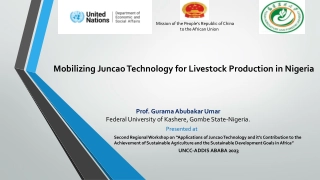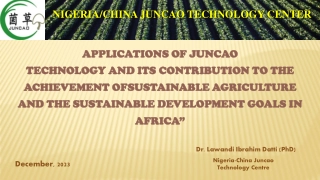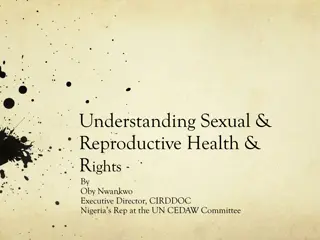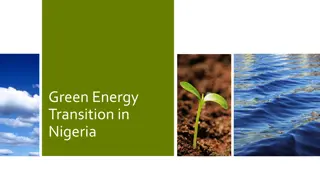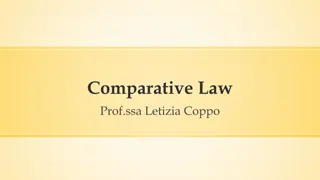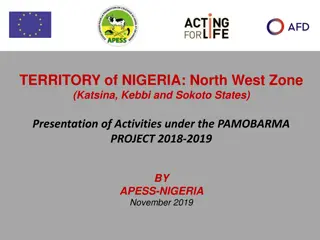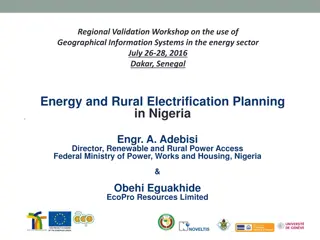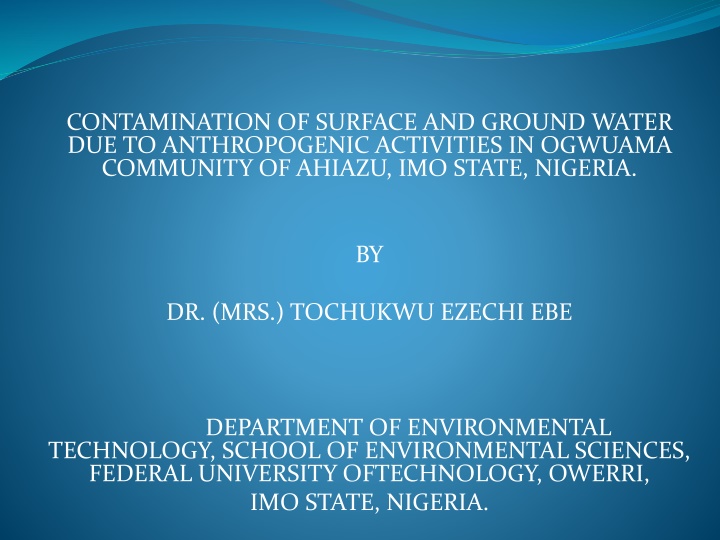
Anthropogenic Contamination of Water in Ogwuama Community, Nigeria
Explore a study on the contamination of surface and ground water in Ogwuama Community, Nigeria, due to anthropogenic activities such as agriculture and waste discharge. The research examines the impact on water quality, microbial load, and physico-chemical parameters, providing insights for environmental conservation efforts.
Uploaded on | 3 Views
Download Presentation

Please find below an Image/Link to download the presentation.
The content on the website is provided AS IS for your information and personal use only. It may not be sold, licensed, or shared on other websites without obtaining consent from the author. If you encounter any issues during the download, it is possible that the publisher has removed the file from their server.
You are allowed to download the files provided on this website for personal or commercial use, subject to the condition that they are used lawfully. All files are the property of their respective owners.
The content on the website is provided AS IS for your information and personal use only. It may not be sold, licensed, or shared on other websites without obtaining consent from the author.
E N D
Presentation Transcript
CONTAMINATION OF SURFACE AND GROUND WATER DUE TO ANTHROPOGENIC ACTIVITIES IN OGWUAMA COMMUNITY OF AHIAZU, IMO STATE, NIGERIA. BY DR. (MRS.) TOCHUKWU EZECHI EBE DEPARTMENT OF ENVIRONMENTAL TECHNOLOGY, SCHOOL OF ENVIRONMENTAL SCIENCES, FEDERAL UNIVERSITY OFTECHNOLOGY, OWERRI, IMO STATE, NIGERIA.
INTRODUCTION Water is very important in our day to day activities. Sources of water in Ogwuama community are stream and ground water. The quality of water source is influenced majorly by anthropogenic activities. Such as cassava fermentation and intensive agricultural practice, washing of cloths, bathing, defecation and discharge of massive amount of waste around the watersource. The quality of water monitoring microbial load especially feacal coliform and physico-chemical parameters like pH, Dissolved oxygen, Biochemical oxygen demand etc. can be determined by
MATERIALS AND METHOD STUDY AREA Ogwuama in Ahiazu Mbaise, Imo State of Nigeria is located within 7o14 348 to 7o18 44 E and 5o31 006 to 5o35 56 N. The climate of the area is humid tropical and typifies the rain forest zone of the equatorial region. Mean ambient temperature is 280C. Wet season last between April to November with a short dry season lasting the rest of year.
SAMPLE COLLECTION Water samples were randomly collected from Onuakpaka stream using 500ml sterile containers points on the downstream and from three different public groundwater method. at three different upstream and using standard
Furthermore, the physico-chemical and microbial analysis were also carried out using standard method. The pH, temperature, conductivity, total dissolved solid and dissolved oxygen were determined in-situ using jenway(Hanna 1910) multipurpose tester in each sampling point while the BOD was determined using a winkler method for a period of five days at 200C.
Table 1: The physico-chemical and microbial analysis results of well water. WHO Standard (2008) 6.5 9.5 N/A FMEMV Standard Ground water 1 Ground water 2 Ground water 3 Mean value Parameter pH Temp (oC) Conductivity (Us/cm) Turbidity (NTU) DO (mg/l) BOD (Mg/l) Total Dissolved solid(mg/l) Total Chloride(mg/l) Total Hardness(mg/l) Nitrate(mg/l) Total faecal count (cfu) Total E-Coli Count(cfu) 6.5 8.5 20 30 6.06 26 6.07 28 6.05 27 6.06 27 100 10 >4 10 100 5 4 6 109 0.00 4.18 1.8 111 0.00 4.20 2.1 107 0.00 4.22 2.1 109 0.00 4.20 2.0 250 250 70.87 70.85 70.83 70.85 250 250 - 145.08 145.10 145.08 200 40 200 45 145.06 22.88 2.1 22.93 2.4 22.89 2.3 22.90 0 N/A 9 11 10 10 0 N/A 9 9 6 8
Table 2: The physico-chemical and microbial analysis results of Upstream. WHO Standard (2008) pH 6.5 - 8.5 6.5 9.5 Temp (oC) 20 30 N/A Conductivity (Us/cm) 100 100 Turbidity (NTU) 10 5 DO (mg/l) >4 4 BOD (Mg/l) 10 6 Total Dissolved solid(mg/l) 250 250 Total Chloride(mg/l) 250 250 Total Hardness(mg/l) 200 200 Nitrate(mg/l) 40 45 Total faecal count (cfu) 0 N/A Total E-Coli Count(cfu) 0 N/A FMEMV Standard Upstream 1 Upstream 2 Upstream 3 Parameter Mean value 5.71 27 6.69 27 5.70 27.3 5.70 27.1 8 10 12 10 14.65 14.30 15.33 14.76 3.57 2.4 3.55 2.0 3.68 1.99 3.60 2.1 6.00 6.40 7.10 6.50 65.9 70.0 82.81 72.9 0.5 0.6 0.7 0.6 10.97 10.90 10.83 10.90 22 22 22 22 9 12 18 13
Table 3: The physico-chemical and microbial analysis results of downstream. WHO Standard (2008) 6.5 9.5 N/A FMEMV Standard Down- stream 1 Down- stream 2 Down- stream 3 Parameter Mean value pH Temp (oC) Conductivity (Us/cm) Turbidity (NTU) DO (mg/l) 6.5 - 8.5 20 30 5.80 27.1 5.90 27.3 6.00 27.5 5.90 27.3 100 10 100 5 11 11 14 12 15.48 15.60 16.14 15.74 >4 10 4 6 3.57 0.79 3.80 0.70 3.85 0.61 3.80 0.70 BOD (Mg/l) Total Dissolved solid(mg/l) Total Chloride(mg/l) Total Hardness(mg/l) Nitrate(mg/l) 250 250 7.10 7.60 8.70 7.80 250 250 150 172.6 224 182.2 200 200 0.65 0.70 0.75 0.70 40 45 0.36 0.28 0.26 0.30 Total faecal count (cfu) Total E-Coli Count(cfu) 0 N/A 28 40 52 40 0 N/A 20 22 27 23
Table 4: The mean standard deviation of the water samples Parameters FMENV Std 6.5-8.5 20-30 100 Well water Up stream Down stream pH Temp (oC) Conductivity (Us/cm) Turbidity (NTU) DO (mg/l) BOD (Mg/l) Total Dissolved solid(mg/l) Total Chloride(mg/l) Total Hardness(mg/l) Nitrate(mg/l) Total faecal count (cfu) Total E-Coli Count(cfu) 6.06 0.01 27.00 1.00a 109.00 2.00b 5.70 0.01 27.10 0.17a 10.00 2.00b 5.90 0.10 27.30 0.20a 12.00 1.73b 10 >4 10 250 0.00 0.00 4.20 0.02 2.00 0.17 70.85 0.02c 14.76 0.52 3.60 0.07 2.13 0.23 6.50 0.56c 15.74 0.35 3.80 0.05 0.70 0.09 7.80 0.82c 250 145.08 0.02d 72.90 8.82d 182.20 3.02d 200 2.30 0.17 0.60 0.10 0.70 0.05 40 0 22.90 0.03e 10.00 1.00f 10.90 0.07e 22.00 0.00f 0.30 0.05e 40.00 5.00f 0 8.00 1.73g 13.00 4.58h 23.00 2.65g h
DISCUSSION The mean pH values recorded showed that ground water, upstream and downstream waters are slightly acidic and below the lower permissible limit recommended by WHO and FMENV. This may be due to the organic contamination which may come from natural leachates, atmospheric droplets and human contamination during fermentationof cassava in the water. The mean temperature of the water samples collected was within the permissible limit.
The mean values of conductivities of ground water is a little bit higher than WHO/FMENV limits while that of upstream and downstream waters are lower. From the mean values of turbidity of the waters, ground water is below the permissible limits while that of upstream and downstream waters were above the permissible limits and can shield the pathogenic organisms. Therefore, the higher the turbidity, the more energy and chemicals required for water treatment (Obasi et al., 2004).
Results of the heterotrophic bacterial count showed that the ground water had the lowest load. This is simply a measure of the number of live bacteria present in water and does not necessarily indicate health threats. Faecal coliform bacteria were detected in all the water samples collected but were a bit much in the downstream water. According to FMENV standards, drinking water should have zero faecal coliform bacterial count in 100ml of the water. It is most likely that faecal contamination arises from human activities.
The mean values of E. coli detected (0.8 x 101Cfu/ml) in the well water, (1.3 x 101cfu/ml) in the upstream water and (2.3 x 101cfu/ml) in the downstream water. E. coli is normally a harmless commensal in the alimentary canal of a man and other animals. However, some sero-types frequently cause gastroenteritis characterized diarrhea with mucus or blood and with dehydration but usually without fever. Children, especially the newborn are usually affected but increasing cases of adult diarrhea caused by E. coli are also being noted (Okafor, 1985). Therefore, the presence of E. coli in the waters makes it potential health risk to its by severe
CONCLUSION Due to the heavy bacterial load, the water sampled were not good drinking and for other domestic activities. There is need to reduce most anthropogenic activities around the water source especially those that have negative impact on the water body such as defecation (both humansand animals), fermentation etc. This will help to improve the sanitization of water for domestic use since the stream and ground water are the majorsourcesof water in this area. Furthermore, sinking of shallow borehole should be discouraged.


